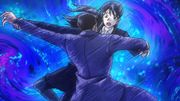Difference between revisions of "Yoshio Urasawa"
Ushiwakamaru (talk | contribs) |
|||
| Line 3: | Line 3: | ||
| image = Yoshio Urasawa.jpg | | image = Yoshio Urasawa.jpg | ||
| gender = Male | | gender = Male | ||
| − | | date-of-birth = January 26, 1951 | + | | date-of-birth = January 26, 1951 |
| − | | place-of-birth = Adachi | + | | place-of-birth = Adachi, Tokyo, Japan |
| location = Tokyo, Japan | | location = Tokyo, Japan | ||
| voice-of = | | voice-of = | ||
| Line 12: | Line 12: | ||
{{nihongo|'''Yoshio Urasawa'''|浦沢 義雄|Urasawa Yoshio}}, born 21 January 1951, is a renowned Japanese screenplay writer Tokyo. He is known from his comical scenarios. | {{nihongo|'''Yoshio Urasawa'''|浦沢 義雄|Urasawa Yoshio}}, born 21 January 1951, is a renowned Japanese screenplay writer Tokyo. He is known from his comical scenarios. | ||
| − | In his early life, | + | == Biography == |
| + | In his early life, Urasawa studied under screenwriters [[Wikipedia: Atsushi Yamatoya|Atsushi Yamatoya]] (大和屋 竺) and [[Wikipedia: Seijun Suzuki|Seijun Suzuki]] (鈴木 清順). He then debuted in 1979 in the 68th episode of the anime ''[[Wikipedia: Lupin the Third|Lupin the Third: Season 3]]'' (ルパン三世 PARTIII). | ||
| + | |||
| + | He also showed his ability to write comedy from 1981 to 1993, in which he participated in the production of the entire ''[[Wikipedia: Toei Fushigi Comedy Series|Toei Fushigi Comedy Series]]'' (東映不思議コメディーシリーズ) as the screenplay. Incidentally, he is the only person who was involved in the screenplay writing for the entire series, for which he has written more than 400 scripts; some famous ones were ''Pettonton'' (ペットントン), ''Bishoujo Kamen Poitrin'' (美少女仮面ポワトリン), ''Mysterious Girl Nile Na Thutmose'' (不思議少女ナイルなトトメス), and ''Sing! Dairyu Miyagi'' (うたう!大龍宮城). Apart from screenplay writing, Urasawa also composed several lyrics for background music in that series, including ''Dokincho! Nemurin'' (どきんちょ!ネムリン) and ''Utau! Dairyu Miyagi'' (うたう!大龍宮城). Owing to this relation, Urasawa's later works contained similar styles with the works produced by Toei; examples would be his ''Akuma-kun'' (悪魔くん) and ''Sandaime wa Onyanko Ojosama?!'' (三代目はおニャン子お嬢さま?!). | ||
| + | |||
| + | During the 1980 period, he was also active under the alias "うらさわよしお", and wrote some scripts for the first season of ''[[wikipedia:ja:世にも奇妙な物語|Tales of the Unusual]]'' (世にも奇妙な物語) back then. From 1993 onwards, he was in charge of the anime ''[[Wikipedia: Nintama Rantarō|Nintama Rantarō]]'' (忍たま乱太郎), whose duration lasted for roughly one fourth of a century, and Urasawa was responsible for 90% of the organizer/screenplay work, which was thus regarded as one of his representative works. Other than the anime version, Urasawa even wrote scripts for the movies of that series in 2011. | ||
| + | |||
| + | In 2003, he published his novel ''Tamago Osho'' (たまご和尚), illustrated by Tamura Noboru (タムラノボル). Afterwards, starting July 2009, he began to write scripts for live-action drama, the TV Tokyo late-night programme, ''We Are Angels! NO ANGEL NO LUCK'' (俺たちは天使だ! NO ANGEL NO LUCK). After that, he concentrated on animation works and returned to the anime series ''Nintama Rantarō''. He also wrote a script for a Crayon Shin-chan movie in 2013: ''[[Wikipedia: Crayon Shin-chan: Very Tasty! B-class Gourmet Survival!!|Crayon Shin-chan: Very Tasty! B-class Gourmet Survival!!]]'' (クレヨンしんちゃん バカうまっ!B級グルメサバイバル!!). | ||
| + | |||
| + | == Style analysis == | ||
| + | <div style="float:right;"> | ||
| + | {| class="chartable" | ||
| + | ! style="width:45px;"|Picture || style="width: 150px;"|Name | ||
| + | |- id="Tango Hohoemi" | ||
| + | | style="width:45px;"|[[File:Tango Hohoemi.jpg|45px]] || style="width: 125px; line-height: 15px;" align="center"|[[Tango Hohoemi]] | ||
| + | |- id="Waltz Hohoemi" | ||
| + | | style="width:45px;"|[[File:Waltz Hohoemi.jpg|45px]] || style="width: 125px; line-height: 15px;" align="center"|[[Waltz Hohoemi]] | ||
| + | |- id="Kayoko Kakurai" | ||
| + | | style="width:45px;"|[[File:Kayoko Kakurai.jpg|45px]] || style="width: 125px; line-height: 15px;" align="center"|[[Kayoko Kakurai]] | ||
| + | |- id="Cutie Mimi" | ||
| + | | style="width:45px;"|[[File:Cutie Mimi.jpg|45px]] || style="width: 125px; line-height: 15px;" align="center"|[[Cutie Mimi]] | ||
| + | |- id="Jurakudai" | ||
| + | | style="width:45px;"|[[File:Jurakudai.jpg|45px]] || style="width: 125px; line-height: 15px;" align="center"|[[Jurakudai]] | ||
| + | |} | ||
| + | </div> | ||
His contributions in ''[[Detective Conan]]'' is rather rebuttable, due to the story style of his works, that consist mostly of comedies. However, several cases written by him reflect certain social status and issues, which can be considered as ''Shakai Detective Fiction'' (社会派推理). | His contributions in ''[[Detective Conan]]'' is rather rebuttable, due to the story style of his works, that consist mostly of comedies. However, several cases written by him reflect certain social status and issues, which can be considered as ''Shakai Detective Fiction'' (社会派推理). | ||
| Line 29: | Line 53: | ||
== Gallery == | == Gallery == | ||
| − | + | Some famous scenes created by him: | |
| − | |||
| − | |||
| − | |||
| − | |||
| − | |||
| − | |||
| − | |||
| − | |||
| − | |||
| − | |||
| − | |||
| − | |||
| − | |||
| − | |||
| − | |||
<gallery widths=180px perrow=5> | <gallery widths=180px perrow=5> | ||
| − | File:EP1028 2.jpg|Conan rarely gives a grimace | + | File:EP1028 2.jpg|Conan rarely gives a grimace |
| − | File:EP1028 Case.jpg|The victim drowned in red bean paste | + | File:EP1028 Case.jpg|The victim drowned in red bean paste |
| − | File:EP1028 1.jpg|Sleeping Kogoro telling the deduction while dancing Waltz | + | File:EP1028 1.jpg|Sleeping Kogoro telling the deduction while dancing Waltz |
| − | File:TV1057.jpeg|Conan flying in the sky | + | File:TV1057.jpeg|Conan flying in the sky |
| − | File:EP1067-12.png|Kogoro doing "security check" | + | File:EP1067-12.png|Kogoro doing "security check" |
</gallery> | </gallery> | ||
| Line 65: | Line 74: | ||
== References == | == References == | ||
| − | # [ | + | # [[wikipedia:ja:浦沢義雄|浦沢義雄 - Wikipedia]] (Japanese) |
| − | # [https://www.imdb.com/name/nm0881576/ | + | # [https://www.imdb.com/name/nm0881576/ IMDb] |
# [https://www.animenewsnetwork.com/encyclopedia/people.php?id=8516 Anime News Network] | # [https://www.animenewsnetwork.com/encyclopedia/people.php?id=8516 Anime News Network] | ||
Revision as of 18:21, 4 October 2023
| Yoshio Urasawa | |
| Profile | |
| Gender: | Male |
|---|---|
| Date of birth: | January 26, 1951 |
| Place of birth: | Adachi, Tokyo, Japan |
| Location: | Tokyo, Japan |
Yoshio Urasawa (浦沢 義雄 Urasawa Yoshio), born 21 January 1951, is a renowned Japanese screenplay writer Tokyo. He is known from his comical scenarios.
Contents
Biography
In his early life, Urasawa studied under screenwriters Atsushi Yamatoya (大和屋 竺) and Seijun Suzuki (鈴木 清順). He then debuted in 1979 in the 68th episode of the anime Lupin the Third: Season 3 (ルパン三世 PARTIII).
He also showed his ability to write comedy from 1981 to 1993, in which he participated in the production of the entire Toei Fushigi Comedy Series (東映不思議コメディーシリーズ) as the screenplay. Incidentally, he is the only person who was involved in the screenplay writing for the entire series, for which he has written more than 400 scripts; some famous ones were Pettonton (ペットントン), Bishoujo Kamen Poitrin (美少女仮面ポワトリン), Mysterious Girl Nile Na Thutmose (不思議少女ナイルなトトメス), and Sing! Dairyu Miyagi (うたう!大龍宮城). Apart from screenplay writing, Urasawa also composed several lyrics for background music in that series, including Dokincho! Nemurin (どきんちょ!ネムリン) and Utau! Dairyu Miyagi (うたう!大龍宮城). Owing to this relation, Urasawa's later works contained similar styles with the works produced by Toei; examples would be his Akuma-kun (悪魔くん) and Sandaime wa Onyanko Ojosama?! (三代目はおニャン子お嬢さま?!).
During the 1980 period, he was also active under the alias "うらさわよしお", and wrote some scripts for the first season of Tales of the Unusual (世にも奇妙な物語) back then. From 1993 onwards, he was in charge of the anime Nintama Rantarō (忍たま乱太郎), whose duration lasted for roughly one fourth of a century, and Urasawa was responsible for 90% of the organizer/screenplay work, which was thus regarded as one of his representative works. Other than the anime version, Urasawa even wrote scripts for the movies of that series in 2011.
In 2003, he published his novel Tamago Osho (たまご和尚), illustrated by Tamura Noboru (タムラノボル). Afterwards, starting July 2009, he began to write scripts for live-action drama, the TV Tokyo late-night programme, We Are Angels! NO ANGEL NO LUCK (俺たちは天使だ! NO ANGEL NO LUCK). After that, he concentrated on animation works and returned to the anime series Nintama Rantarō. He also wrote a script for a Crayon Shin-chan movie in 2013: Crayon Shin-chan: Very Tasty! B-class Gourmet Survival!! (クレヨンしんちゃん バカうまっ!B級グルメサバイバル!!).
Style analysis
| Picture | Name |
|---|---|
| Tango Hohoemi | |
| Waltz Hohoemi | |
| Kayoko Kakurai | |
| Cutie Mimi | |
| Jurakudai |
His contributions in Detective Conan is rather rebuttable, due to the story style of his works, that consist mostly of comedies. However, several cases written by him reflect certain social status and issues, which can be considered as Shakai Detective Fiction (社会派推理).
Scenarios written
Number of case scenarios written: 9 (9 episodes)
- The Tokyo Barls Collection (Episode 943)
- The Secret of the Insect Man (Episode 955)
- Follow Them! Detective Taxi (Episode 976)
- Intrigue at Smile Village (Episode 997)
- The Idol Whose Smile Disappeared (Episode 1010)
- Ballad of the Woman Who Loved Cake (Episode 1028)
- Bad Guys (Episode 1057)
- The Shopping Center in Love (Episode 1067)
- The Genius Restaurant (Episode 1089)
Gallery
Some famous scenes created by him:
Other notable works
Anime
- Digimon (18 episodes): Screenplay
- Powerpuff Girls (18 episodes): Screenplay
- Crayon Shin-Chan (Movie 21): Screenplay
- Hello Kitty: Series composition
- Kamen Rider (Live-action 3D movie): Screenplay
- Lupin III (4 episodes + 1 movie): Screenplay
- Ranma ½ (4 episodes): Screenplay
- Many other animes including Nintama Rantaro, Blue Dragon, and Osomatsu-kun...
References
- 浦沢義雄 - Wikipedia (Japanese)
- IMDb
- Anime News Network






